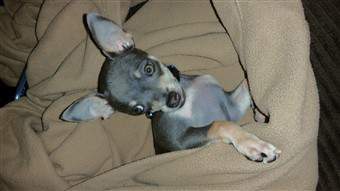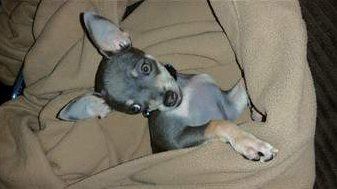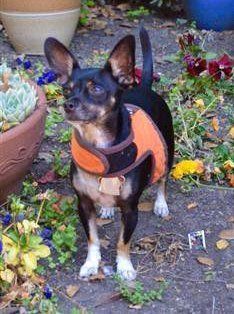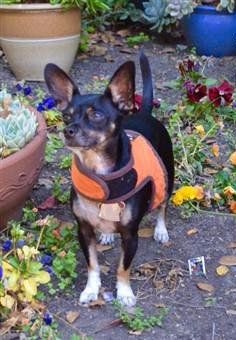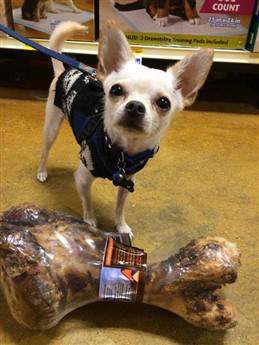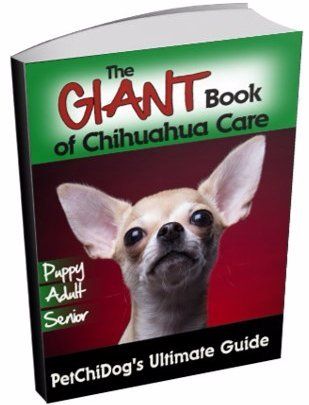Chihuahua Calorie Requirements
Overview
With the Chihuahua being the smallest of all dog breeds in the world, it is natural for owners to be concerned about a Chi puppy or dog receiving enough nutrition. And a large part of this is wondering how many calories a Chihuahua needs to eat each day.
Puppies need enough calories to grow, adults need enough to maintain and in very rare cases, an older Chihuahua may need to have a decrease to lose weight (this is most common with senior Chi that were already larger than the standard and most often due to growing more sedentary as they age, they have gained weight).
Since making sure that your Chihuahua is receiving proper nutrition, this page will focus on calorie requirements for the Chi. We’ll round things out with some helpful Q&A from readers asking common calorie related questions.
Please note:
PetChiDog is reader-supported. Some of the product suggestions on this page are affiliate links. As an Amazon Associate we earn from qualifying purchases. This is at no extra cost to you and helps keep this site running.
Elements that Affect How Many Calories a Chihuahua will Need
There are several factors that affect calorie requirements for dogs. This is important to note and the main reason why a single number is not given for all Chihuahuas. A range is given instead. What affects this number?
1) Age
– This plays a huge role. You may have heard that puppies need more calories than adults in order to grow. This is a bit misleading. Puppies need more calories per pound of body weight. If you had a 3 lb. growing puppy and a 3 lb. adult Chihuahua, the puppy would need more calories than his adult counterpart.
It is rapid growth that calls out for fuel. Chihuahua newborns double in size within days. Young puppies
grow at an exponential rate. Most growth is done by the 9-month mark, with the puppy filling out just a bit more and perhaps gaining a pound from 9 to 12 months. By the 1-year-old mark, a Chihuahua is considered to be an adult and calorie needs will change at that time.
As a Chihuahua matures into an adult, he needs fewer calories per pound of body weight to maintain. Once a Chi becomes a senior dog (most veterinarians declare this to be at the 8 or 9-year mark), he often needs fewer calories than his younger counterparts. This is most often due to the dog exercising less (both in intensity and duration) and an overall slowing down (less playing, etc.).
Poppy
Photo courtesy of Sharrel Carroll
2) Activity Level
– Calories are burned off every second, including when a Chihuahua is sleeping. The rate at which calories are burned fluctuates throughout the day.
There are 2 types of activity that affect how many calories are burned:
1. Exercise
– Purposeful exercise such as walking at a brisk pace, playing fetch, running around a yard (fenced in and supervised, hopefully) and other such activity that raises the Chihuahua’s heartbeat will burn calories. The number is not that impressive, however you must remember that this is all relative.
For a human, these numbers are low. For a small Chihuahua that only needs a few hundred calories per day, this number means a lot more.
There have not been a lot of studies done, however one that is pointed out quite often estimates that a 20-pound dog walked for 15 minutes at a good pace (3.7 to 4 miles per hour) will burn 64 calories. A recommended 30-minute walk would equal 128 calories. If we apply this to a Chihuahua, we have a 5-pound dog walked at a toy breed’s pace of 2 miles per hour for a calorie burn of approximately 25 calories.
If a Chihuahua is exercised
2 times per day, this puts the total number of calories burned at 50.
If that dog requires 250 calories per day, he burns off 1/5 of them via exercise.
2. NEAT
– This stands for Non-Exercise Activity Thermogenesis. This refers to the calories that a body (for any living creature) burns just ‘being’. Even at rest and sleep, the body burns calories to maintain itself. When awake, things such as a dog thumping his tail, playing with his toys, and barking all add up.
The reason why this plays into the calorie needs for a Chihuahua is because some dogs are naturally more active. Some dogs will pace for hours when home alone, run and jump and tumble around when his owners are home, be very animated with their chewing toys, etc. Usually when an owner believes that their dog has a very high metabolism, this most often is due to the dog making lots of small movements all day long, increasing his NEAT to a point that he seemingly burns off everything he eats and then some.
3) Health Status
– The main way in which this affects how many calories a Chihuahua needs is related to how an injury or illness affects the dog’s ability to be exercised as normal.
Exceptions to this are pregnant dogs that need a big boost in calories, particularly during the second half of the pregnancy and nursing dogs that need extra calories to fuel milk production. Appetite increases by about week 5. A pregnant Chihuahua will need about 25% more calories than normal by the time she is ready to give birth. A lactating Chihuahua that is nursing puppies will need approximately 15% more calories per day for each puppy. Therefore, with a litter of two pups, she may need up to 30% more food.
There are a couple of health conditions
that can affect a dog’s metabolism, which in turn will affect how many calories he needs. Thyroid issues are at the top of this list.
Does Spaying or Neutering a Chihuahua Affect Calorie Needs?
There are a lot of misconceptions regarding the question of a dog gaining weight after being fixed. And you may be wondering if your Chihuahua needs fewer calories if he or she has been fixed. In most cases, the answer is that his/her calorie requirements will fluctuate very slightly, though not enough to make a difference in how you feed your dog.
The only element ever proven in studies is that a dog may be less active due to urges to run away, taking chase, etc. The number of calories burned by a dog carrying out his hormonal urges is very minimal.
Myles (blue Chihuahua)
Photo courtesy of the Mitich Family Charlotte, North Carolina
To further back this up, a study published by the Journal of the American Veterinary Medical Association (JAVMA) in 2013 compared 1930 spayed and neutered dogs to 1669 intact dogs over the course of 10 years. Only during the first 2 years following the procedure did some of the dogs have a slight increased risk of weight gain.
How Many Calories a Chihuahua Puppy Needs
Now that you know how elements such as age and activity affect the number of calories that a Chihuahua needs, you’ll realize that a range must be given. Calories needs are based on the weight of the Chihuahua. Since young puppies grow rapidly, but can have stalls and jumps, the number will change frequently.
In general, puppies need about 55 calories per day, for each pound of body weight. And this number can go down or up by 20% depending on the particular dog, his activity level, metabolism, etc.
Let’s take a look at the guidelines:
Weight = Calories per Day
1 lb. (0.45 kg) = 40 to 60
1.5 lbs. (.68 kg) = 64 to 96
2 lbs. (0.90 kg) = 80 to 120
2.5 lbs. (1.13 kg) = 111 to 165
3 lbs. (1.36 kg) = 120 to 180
3.5 lbs. (1.58 kg) = 154 to 232
4 lbs. (1.81 kg) = 160 to 240
4.5 lbs. (2.04 kg) = 198 to 298
5 lbs. (2.26 kg) = 200 to 300
5.5 lbs. (2.49 kg) = 243 to 363
6 lbs. (2.72 kg) = 254 to 396
How Many Calories a Chihuahua Adult Dog Needs
Once a Chihuahua is done growing, he will need fewer calories per pound of body weight to maintain his weight.
Mole, 18 months old
Photo courtesy of Helane Zeiger
Though growth is done, calorie burn is still relatively high as many adult Chihuahua dogs are also now exercising more. They can walk longer and faster than their younger counterparts. They are often carried less and brought to more places where they can roam around, explore and move. In regard to how many calories a Chi needs each day, this all factors in to an adult dog needing roughly 40 calories for each pound of body weight.
Let’s take a look at the guidelines:
Weight = Calories per Day
2.5 lbs. (1.13 kg) = 80 to 120
3 lbs. (1.36 kg) = 96 to 144
3.5 lbs. (1.58 kg) = 112 to 168
4 lbs. (1.81 kg) = 128 to 192
4.5 lbs. (2.04 kg) = 144 to 216
5 lbs. (2.26 kg) = 160 to 240
5.5 lbs. (2.49 kg) = 176 to 264
6 lbs. (2.72 kg) = 192 to 288
6.5 lbs. (2.94 kg) = 208 to 312
7 lbs. (3.17 kg) = 224 to 336
7.5 lbs. (3.4 kg) = 240 to 360
8 lbs. (3.62 kg) = 256 to 384
8.5 lbs. (3.85 kg) = 272 to 408
9 lbs. (4.08 kg) = 288 to 432
Senior Chihuahua Dogs
In general, it is said that older, senior dogs need fewer calories each day than adult dogs. This is attributed to the fact that some older dogs are less active; they may exercise less often and may nap more. However, this does not apply to all senior and this certainly does change depending on how old the dog is.
A ‘young’ senior of 8, 9 or even 10 years old may be just as active as ever without any slowing down at all. As a Chihuahua reaches the 12-year mark or into his early teens, arthritis and other age related conditions do often come into play.
For the senior Chi that is much less active, calorie needs may fluctuate in the 30 to 35 calories per pound of body weight range.
It is common for a senior Chihuahua
to display a weaker appetite and in many cases this is the dog adjusting for his lower requirements.
Should You Count Calories When Feeding Your Chihuahua?
While it is good to know how many calories your puppy or dog needs, this is just part of the equation in making sure that your Chihuahua eats enough and is receiving optimal nutrition. It can be very difficult to count calories when feeding a dog.
Adding up amounts, including snacks, can become quite tedious, especially if you offer any non-manufactured foods such as veggies and fruits. In general, all of those calculations is a lot of work when there are other things to be looking at. Better, is to keep track of how your puppy is growing and whether or not your adult Chihuahua is keeping his weight steady.
For these reasons, it is recommended to follow the feeding guidelines on the particular brands that you give to your Chihuahua.
Calories in Dog Food
Does the calorie count tell you if a food is good or not? Not really: Some cheap brands pack the food with fillers, which make the meal as a whole contain fewer calories.
With other inexpensive varieties, it will be packed with fatty by-products which can take the calories up. For this reason, calorie analysis alone does not tell you how good a particular food is.
Let’s see how the calories in these options stack up:
- Low quality, dry food (First Choice Dry): 475 calories per cup.
- Low quality wet food (Natural Balance Dog Food - Rolled): 528 per cup.
- High quality dry food (Orijen Tundra): 461 calories per cup
- High quality wet food (Life’s Abundance - Canned)): 469 calories per cup
This is an example of why owners should take note of the quality of the food and not the calorie count.
Decreasing Calories for a Chihuahua
This breed rarely has problems with excess
weight gain, though there are some exceptions such as Chi that are naturally larger than the standard and have aged and/or become sedentary.
Gizmo Meeko at 1 yr, 9 mths old | Photographer: Adriana
Photo courtesy of The Trezza/Vadjinia Family
If a veterinarian has recommended that a Chihuahua needs to lose weight, this should be done with a combination of lower calories (not less food) and an increase in exercise (if the dog is able).
An important note is that the same amount of food can be given while decreasing calorie count. This can be accomplished by replacing some higher calorie ingredients with lower calorie ones. Green vegetables are a great choice that can easily be mixed into kibble.
There are also brands that offer a diet or low calorie variety and this is a good option as well. For snacks, fruit (blueberries, raspberries, mango) or veggies (carrots, baby peas) can be healthy options.
Increasing Calories
If a Chihuahua puppy is not growing as expected, the pup will need to be examined by a veterinarian, as it is often not just as simple as
feeding the dog more or a higher calorie food. Weight loss or inability to gain weight can be due to a number of issues including worms and parasites.
Then, there are some tiny Chihuahuas (most often those dubbed teacups or miniatures) that are undersized and struggle to grow or maintain. Though any issues such as this should be discussed with the vet, he or she may suggest a supplement to encourage the absorption of nutrients.
One of the top rated supplement powders to help with this is:
Just one tiny teaspoon sprinkled onto a Chihuahua's food each day often does the trick and it has a taste that is appealing to dogs. Not only does it help a dog's body absorb the nutrients that he/she is ingesting, it also can help a great deal with stomach troubles, gas, bloating and issues such as loose stools.
Some owners have also noticed improvement with copraphagia
(when a dog eats his own or other dog's poop).
Reader Q&A:
Q: My 2-year-old, 2 and ½ pound Chihuahua never wants to eat. I was thinking about offering the highest calorie food possible, so that when she does eat, at least it will have the most effect. What are your thoughts?
A:
A huge percentage of Chihuahua owners worry that their dog is not eating
enough. In many cases, this worry is not warranted. And this is because this tiny toy breed dog does not need very much to maintain. Your 2-and-a-half-pound Chihuahua only needs 80 to 120 calories a day. If you feed her 2 meals per day, this means she only needs 50 calories per meal, which is a mere 1/8 cup per meal (in general).
So, as long as she is not losing and you are offering a 4 or 5 star brand, you should have nothing to worry about.
Q: Some days my Chihuahua gets lot of exercise but some days he is barely mobile.
This is due to my crazy
schedule. Should I feed him more on the active days and less on the others? And is so, by how much?
A:
In general, if you try to adjust servings to an exact amount based on how many calories your Chihuahua is burning off, you’ll drive yourself nuts trying to figure it all out. Though, with this said, on days that he is getting lots of cardio, his appetite may increase and there is nothing wrong with making his meals a bit larger or adding in a couple of extra snacks. As always, we suggest making these as rewards for good behavior or to reward him for listening to commands.
The most important thing is to increase his water intake as his water requirements will shoot up if he’s exercising a lot.
Things you may wish to do now:
Become a free PetChiDog Member
- You will be able to receive friendly reminders when we add new pages of information onto this site. You will also be able to suggest a topic for us to write about. * If you are already a Member, just reply to any newsletter with your idea.
Check out the Chihuahua Supplies page
- This is a great round-up of top recommend items for optimal care, comfort, safety, and happiness.
Check out our book
- The GIANT Book of Chihuahua Care. In both print & eBook. The most comprehensive Chi care book in the world. From newborn, to senior and everything in between.


